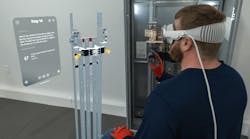One of the most interesting aspects of the electrical industry is the tremendous breadth of products that it supplies to construction projects of all sizes. Whether it's a new light switch for a lamp in a meat locker of the local grocery story or a lighting control system for a state-of-the-art performing arts center, electrical distributors, manufacturers, independent reps and electrical contractors are there.
Sometimes they get involved in some pretty unusual and outright famous construction projects. This article features several of these construction jobs. If your company is working on an interesting new construction project or retrofit job, please contact Jim Lucy, chief editor, at (913) 967-1743, and we will consider it for publication.
Anything but Conventional
David L. Lawrence Convention Center, Pittsburgh, Pa.
Convention centers usually don't attract much attention. The vast lobbies and endless hallways and miles of aisles of trade show booths have a certain sameness to them. But Pittsburgh's newly constructed David L. Lawrence Convention Center caught the eye of the U.S. Green Building Council, and has won accolades as one of the most energy-efficient buildings on earth. A signature project of Latin American architect Rafael Vinoly, today the convention center also stands as the largest Gold LEED-certified (Leadership in Energy and Environmental Design) “green” building in the world.
Figuring prominently in the construction of the facility was Leviton Manufacturing Co. Inc., Little Neck, N.Y., which supplied lighting controls and daylighting systems. “Leviton's participation in this world-class project presented a unique opportunity for us to demonstrate our expertise in the area of advanced energy-efficient lighting control solutions,” said Tom Leonard, director of marketing for Leviton's Lighting Energy Management Systems division. “Several Leviton architectural, daylight harvesting and relay control systems were installed throughout the facility to offer the optimum combination of both functional and energy-efficient lighting control.”
Leviton's daylighting system harvests natural sunlight by integrating it along with artificial light through the use of photocell sensors at the convention center. Leonard says by harvesting natural daylight and integrating other high-efficiency lighting components, Leviton was able to cut lighting energy consumption 35 percent for the convention center. “This translates into an annual savings of over $500,000, which goes directly to the bottom line,” he says.
Blending the Best of Old and New
Bardavon Theater, Poughkeepsie, N.Y.
Way too many Main Street cinemas from a bygone era have been crushed by the omnipresent multiplex movie monstrosities at shopping malls. The Bardavon 1869 Opera House, located in Poughkeepsie, N.Y., has survived, though, with the help of some innovative lighting design and a grant from a public agency promoting energy efficiency.
Hosting entertainment for Hudson River Valley residents for more than 130 years, the Bardavon's list of performers include author Mark Twain, crooner Frank Sinatra and dancer Martha Graham. A victim of suburban cineplexes, the Bardavon closed in 1975 and was slated for demolition when local residents rescued the elegant venue. As part of the renovation project, the Bardavon's original three-sided 1940s era marquee and the vertical blade sign were replaced with replicas that still used incandescent light bulbs as light sources. Later, the 3,600 incandescent lamps were replaced with energy-efficient light-emitting-diode (LED) bulbs from LEDtronics Inc., a manufacturer of LED lamps based in Torrance, Calif.
A grant from New York State Energy Research & Development made it possible for the nonprofit Bardavon theater to switch to LED-sourced lighting. Knowledgeable about LED's reputed long life and power savings, Bardavon's Jason Adams contacted LEDtronics. Following discussions with LEDtronics regional representative, Jeff Mizel, and after testing several sample lamps, Adams purchased 3,600 white, yellow, orange, red and blue-green LEDs. The LED lamps feature 25mm Edison-screw bases that enabled them to be installed into existing sockets without requiring pricey modifications.
The marquee and the blade sign typically operate for six to eight hours per show about 150 times a year, which averages about three hours a night over the course of a year. The theater was hit with an annual electrical bill of $3,445 for the 11W S14 incandescent lamps, while electricity for the 1.3W LED lamps with their 100,000-hour lamp life cost $124.40, an annual savings of $3,220.50 a year, approximately $9,615 over the three-year warranty period, and $35,233 over the typical 100,000-hour LED operating life. The annual energy saved is 38,237Kwhs.
Besides lower energy costs, the Bardavon has benefited from the lower maintenance costs. The older incandescent lamps, which had a lamp life of approximately 1,000 hours, had to be replaced approximately once a year, and a boom truck had to be rented for the maintenance. Assuming labor for changing the bulbs was $13 an hour, the cost of replacing the 3,600 lights, including the cost of labor, new lamps, boom lift rental and operator pay was more than $51,000. The 100,000-hour lamp life of the LEDs eliminates this annual relamping. LEDtronics estimates that the theater annually saves more than $57,000 in power savings and maintenance, and that these savings quickly paid for the LEDs. Reducing energy and maintenance expenses freed up resources for the theater's other restoration projects.
Out-of-this-World Lighting Design
National Air and Space Museum, Smithsonian Institution, Chantilly, Va.
If you ever need a taste of the latest in lighting design, check out the annual winners of the GE Edison Award, presented by GE Lighting, Nela Park, Ohio. This awards competition recognizes the most innovative lighting designs in the world.
The 2004 GE Edison Award was awarded to Frank A. Florentine, William Jacobs and David M. Heck of the National Air and Space Museum, Smithsonian Institution for lighting the museum's James S. McDonnell Space Hangar at the Steven F. Udvar-Hazy Center in Chantilly, Va. Shepherd Electric Co. Inc., Baltimore, supplied the GE Lighting lamps for the project. The museum features more than 600 large space artifacts, including the Shuttle Enterprise.
Playing the Long Shots
Churchill Downs, Louisville, Ky.
Imagine a renovation project valued at more than $95 million dollars on the corporate headquarters of a half-billion-dollar corporation, a world-famous sports venue, a busy retail operation, a museum with over 75,000 visitors annually, or even a top-rated equestrian training facility.
Now picture the work on all of these facilities at once with only 20 months to complete the job. That was the challenge for electrical contractor Bruce Henderson, president of Henderson Services LLC and his team, as the Louisville, Ky.-based company took on the electrical renovation of historic Churchill Downs racetrack, home of the Kentucky Derby. To further complicate matters, all facilities had to maintain regular operations during the construction period. This included the running of Kentucky Derby in 2004, right at the midpoint of the construction schedule.
This project represents the largest capital improvement to the track since the famed twin spires and the grandstand below were completed in 1895. The renovation project included the demolition of about 40 percent of the track's seating capacity and new construction of luxury suites, restaurants and premium seating facilities. In addition, new power, data and communication systems were completed through the entire property, including a new race control center and a media center for broadcasts during big events.
“By far our biggest challenge was to be ‘race ready’ for the Oaks and the Derby in 2004 and be 100 percent complete by Oaks and Derby 2005,” said Henderson. The 2004 races required a complete temporary race control center, a broadcast infrastructure to support the media center, temporary catering facilities in some portions of the newly constructed areas and new operational public address and fire-alarm systems throughout both old and new sections of the facility. Another factor was the care of thousands of expensive thoroughbred racehorses that stable and train at the track throughout the year. Noise and other considerations were addressed regularly during the construction process.
Because of the complexity of the demolition and the normal operation of the track, project logistics were a real problem. Henderson labeled the solutions as a ‘collective effort’ between manufacturers, distributors and reps, to meet the demands of the job. Local lighting manufacturer Genlyte helped in scheduling multiple shipments of various fixtures for the job. Local manufacturer's rep Pfeiffer Sales Co. Inc., Louisville, Ky., also helped with available warehouse space approximately two miles from the job location. A Henderson employee was on site at the Pfeiffer Sales warehouse location coordinating the multiple just-in-time shipments to the track each day.
Cost control was also paramount. Because the project represented a large portion of the total revenue for Henderson in 2004, labor costs and productivity were watched closely, especially as the schedule began to compress and daily manpower requirements increased. Because the job was highly specified, Henderson was unable to use many labor-saving products they would normally employ in their design-build work to help with the tight schedule. The use of Allied Tube Kwik-Fit EMT did help speed up the installation of many overhead, large diameter, multiple conduit runs, a significant design element in the project.
— Mark MacAller, Strategic Marketing & Business Solutions, Louisville, Ky.
All Products Great and Small
Empire State Building, New York, N.Y.
O-Z/Gedney, a division of EGS Electrical Group based in Rosemont, Ill., recently discovered that some of its cable supports are still in service at one of the most famous buildings of them all: the Empire State Building. When building the Empire State Building 75 years ago, engineers found that the heavy electrical cable installed in vertical raceways or risers imposed excessive strain on terminations, panels and other connected devices.
To answer the challenge, the project engineers asked O-Z/Gedney, then known as the O-Z Cable Support Co., to furnish cast iron and hardwood cable supports. Many of those same cable supports remain in service. Then and now, O-Z/Gedney cable supports utilize the exclusive pOZi-grip Wedging Plug, a unique manufacturing technique that coats the cable grooves with course grain grit to significantly improve the support's holding power without damaging the jacket or insulation on the cable. It's estimated that the 103-story, 1,434-foot tall Empire State Buildings has 2.5 million feet of electrical wire carrying the 40 million-kilowatt hours used by the building and its tenants annually.
The Biggest Trophy Jobs of Them all
As long as we're talking about the biggest construction jobs electrical distributors, manufacturers and reps have worked on during the past year, we should take a look at some of the biggest jobs of them all — the tallest office towers in the world. Some of these projects have already broken ground; others are now moving through the initial stages of approval and design. They all have one thing in common: they were once or will soon be the tallest building in the world.
Taipei 101
The 101-floor office tower in Taipei, Taiwan, is currently the tallest building in the world. It's 1,671 feet tall to the tip of its spire. Architect C.Y. Lee designed the exterior of the building to resembles bamboo segments, with eight stories to each segment because the number “8” signifies prosperous growth.
Burj Dubai
When architects set out to design the tallest buildings in the world, it seems they usually try to top the current tallest building by a surprisingly small amount, often just a few feet. But the Burj Dubai “supertower” in Dubai, United Arab Emirates, will smash all of the records. Scheduled for completion in 2008, it's estimated that Burj Dubai will be between 2,296 and 2,624 feet tall — nearly one half mile tall. The exact height is a closely guarded secret.
Petronas Towers
With its dual spires towering 1,483 feet above Kuala Lampur, Malaysia, the Petronas Towers is one of the most unique buildings ever built. It held the title of world's tallest building until the completion of Taipei 101.
Empire State Building
Although it's long since relinquished its title as the tallest building in the world, with its 110 floors, the 68-year-old Empire State Building has held up surprisingly well in the listings of the world's tallest buildings. Measured at 1,250 feet to the top of its roof, the building's classic Art Deco design and symmetrical shape still epitomizes the skyscraper.








